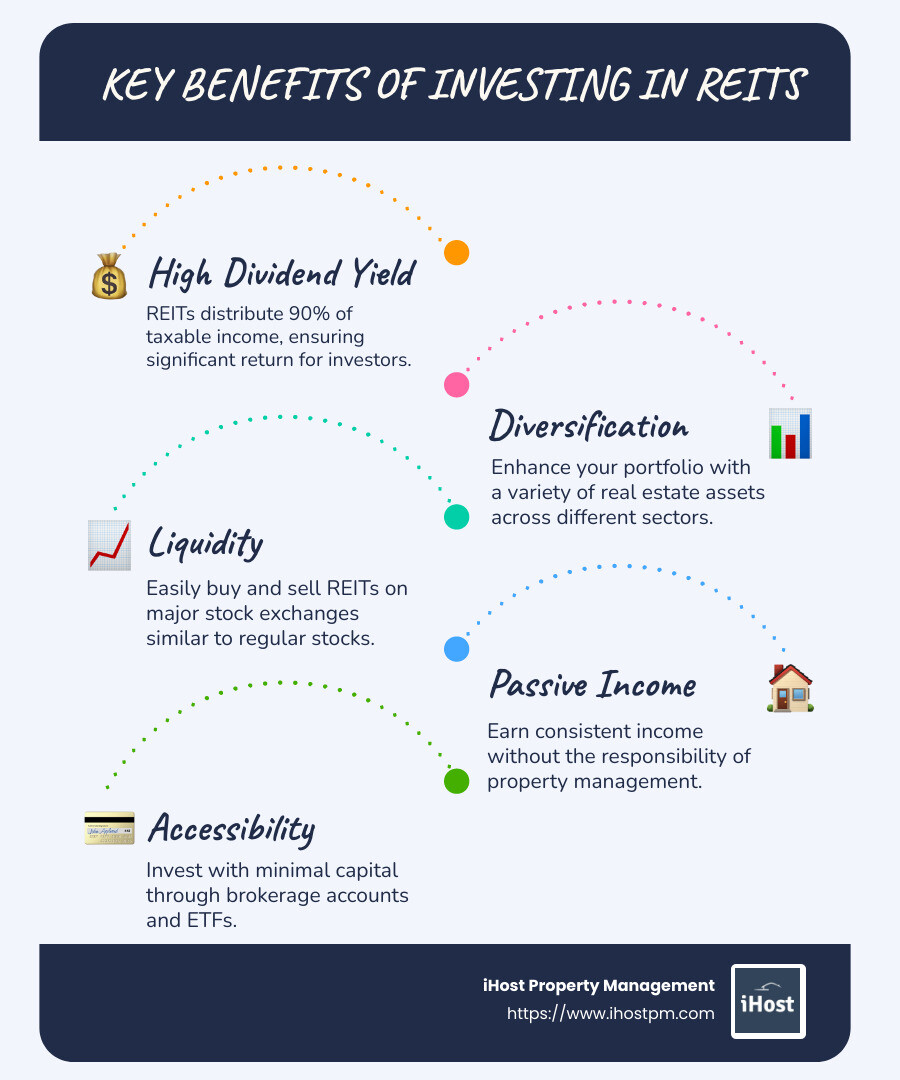Real estate investment trust is a company that owns, operates, or finances income-producing real estate. It’s an investment opportunity that allows you to earn steady income without the complications of directly buying properties. Instead, you buy shares in companies that manage real estate portfolios, much like investing in stocks. This provides a way to include real estate in your financial plan without the need for significant capital or direct property management.
- High Dividend Yield: REITs are required to pay out 90% of their taxable income, offering attractive dividends.
- Diversification: Investing in REITs adds variety to your portfolio, balancing risk across different sectors.
- Liquidity: As most REITs are traded on major stock exchanges, they can be bought and sold like regular stocks.
I’m Gary Gilkison, founder and CEO of iHost Property Management. With experience in real estate investment trusts, I specialize in automated property management and data-driven investment strategies. Our goal is to help clients maximize their rental profits with minimal effort, focusing on Northern California’s booming short-term rental market. Now, let’s explore how REITs could transform your investment approach.

Understanding Real Estate Investment Trusts
Real estate investment trusts (REITs) are companies that own, operate, or finance income-generating real estate. They offer a unique way to invest in real estate without the hassle of directly managing properties, making them an attractive option for those interested in diversifying their investment portfolio.
Types of REITs
There are several types of REITs, each with its own focus and investment strategy:
-
Equity REITs: These are the most common type of REITs. They own and manage income-producing properties like shopping malls, hotels, and office buildings. Equity REITs generate revenue primarily through leasing space and collecting rent from tenants.
-
Mortgage REITs (mREITs): Instead of owning properties, mREITs provide financing for income-producing real estate by purchasing or originating mortgages and mortgage-backed securities. Their income comes from the interest earned on these financial assets.
-
Public Non-Listed REITs: These REITs are registered with the SEC but do not trade on national stock exchanges. They offer a middle ground between public and private REITs, providing some liquidity while avoiding the volatility of the stock market.
-
Private REITs: These are not traded on public exchanges and are only open to accredited investors. Private REITs offer potential for higher returns but come with more risk and less liquidity.
How REITs Make Money
The investment model of REITs is straightforward. Here’s how they generate income:
-
Leasing and Rent Collection: Equity REITs lease space in their properties to tenants. The rent collected forms the primary source of income, providing a steady cash flow.
-
Dividends: REITs are required to distribute at least 90% of their taxable income to shareholders as dividends. This makes them an attractive option for investors seeking regular income.
REITs have transformed the real estate investment landscape by making it accessible and liquid. Instead of dealing with the complexities of property ownership, investors can enjoy the benefits of real estate through shares in REITs. This model not only provides a steady income stream but also offers diversification and liquidity, making REITs a compelling choice for many investors, especially those interested in the dynamic real estate market of Northern California.

Benefits of Investing in REITs
Investing in real estate investment trusts (REITs) offers several attractive benefits that make them a popular choice among investors. Let’s explore some of the key advantages.
Competitive Returns
Diversification is one of the major benefits of investing in REITs. By adding REITs to your portfolio, you can spread your investment across various real estate sectors like healthcare, retail, and office spaces. This helps reduce risk since different sectors can perform differently under varying economic conditions.
Passive income is another compelling reason to invest in REITs. Since they are required to pay out at least 90% of their taxable income as dividends, REITs can provide a steady stream of income. This makes them an excellent choice for those looking to generate regular income without the hassle of managing properties.
REITs also serve as an inflation hedge. Many REITs have properties with leases that allow rent increases tied to inflation, helping maintain the value of your investment over time.
When it comes to historical performance, REITs have shown competitive returns compared to other asset classes. For example, the FTSE NAREIT All Equity REITs Index has historically outperformed the S&P 500, offering an average annual return of 11.8% from 1972 to 2019. This track record makes REITs a reliable option for both income and growth.
Accessibility and Liquidity
One of the standout features of REITs is their accessibility. Unlike direct real estate investments, which can require significant capital and expertise, you can buy REIT shares through a brokerage account, just like any other stock. This makes it easy for investors of all sizes to participate in the real estate market.
Liquidity is another advantage. Publicly traded REITs are listed on major stock exchanges, allowing investors to buy and sell shares with ease. This flexibility is particularly beneficial compared to the illiquid nature of direct real estate ownership.
For those who prefer a diversified approach, exchange-traded funds (ETFs) that focus on REITs are available. These funds invest in a variety of REITs, providing instant diversification and reducing the risk associated with individual stocks.
In summary, REITs offer a unique combination of competitive returns, diversification, and accessibility. They provide a way to enjoy the benefits of real estate investment without the complexities of property management. Whether you’re seeking passive income, a hedge against inflation, or simply a liquid investment, REITs have something to offer.
Risks and Challenges of REITs
Investing in real estate investment trusts (REITs) comes with its own set of risks and challenges. Understanding these can help you make informed investment decisions.
Limited Growth Potential
One of the key challenges with REITs is their limited growth potential. By law, REITs must distribute at least 90% of their taxable income as dividends to shareholders. This means they have limited funds available for reinvestment into new properties or projects. As a result, REITs may not experience the same level of capital appreciation as other investments that reinvest more of their earnings.
Moreover, since REIT dividends are taxed as regular income, this can eat into your returns, especially if you’re in a higher tax bracket. It’s essential to weigh the benefits of steady dividend income against the limited potential for growth.
Geographic and Sector Focus
Another significant risk is the geographic and sector focus of REITs. Many REITs concentrate their investments in specific regions or sectors, such as healthcare or retail. This can expose investors to regional risks like economic downturns or natural disasters that might impact property values or rental income in those areas.
For instance, a REIT heavily invested in retail properties may face challenges if consumer shopping habits shift significantly towards online platforms, reducing demand for physical retail spaces. Similarly, a REIT focused on a particular geographic area might suffer if that region experiences an economic slump.
Market Fluctuations
REITs are also subject to market fluctuations. Changes in economic conditions, interest rates, and investor sentiment can all impact REIT performance. For example, rising interest rates can make borrowing more expensive, affecting a REIT’s ability to finance new acquisitions or refinance existing debt. Higher interest rates can also make REIT dividends less attractive compared to other income-generating investments, potentially driving down share prices.
Occupancy Rates
Occupancy rates are another critical factor that can affect REIT performance. High vacancy rates can reduce rental income, impacting a REIT’s ability to pay dividends. This is particularly relevant for REITs invested in sectors like office spaces or hotels, where occupancy can fluctuate based on economic conditions or industry trends.
In summary, while REITs offer attractive benefits, they also come with risks that investors need to consider. Understanding these challenges can help you better assess whether REITs align with your financial goals and risk tolerance.
How to Invest in Real Estate Investment Trusts
Choosing the Right REIT
Investing in real estate investment trusts (REITs) can be a smart way to diversify your portfolio and earn passive income. But how do you choose the right REIT for your investment goals? Let’s break it down.
Brokerage Accounts and ETFs
To get started with REITs, you’ll need a brokerage account. This is your gateway to buying shares of individual REITs or exchange-traded funds (ETFs) that focus on real estate.
-
Brokerage Accounts: These accounts allow you to purchase individual REIT stocks directly. This approach gives you control over your investments but requires more research to choose the right REITs.
-
ETFs: These are excellent options if you’re looking for diversification without having to pick individual REITs. ETFs pool money from many investors to buy a broad range of REITs, spreading out risk. They’re traded on stock exchanges, making them accessible and liquid.
Aligning with Financial Goals
Before diving into REITs, consider your financial goals. Are you looking for steady income, long-term growth, or both? REITs are known for their dividend income, which can be appealing if you’re seeking regular cash flow. On the other hand, if growth is your priority, you might want to look at REITs with a history of capital appreciation.
Property Types and Market Trends
Different REITs focus on different types of properties, such as healthcare facilities, retail spaces, or data centers. Understanding these property types can help you align your investments with market trends.
- Healthcare REITs, for example, might benefit from an aging population.
- Retail REITs could be risky if consumer behavior shifts away from physical stores.
- Industrial REITs might see growth with the rise of e-commerce.
Keep an eye on market trends to identify which sectors are ready for growth. This can guide your decision on which REITs to invest in.
Consider Regional Focus
While REITs offer diversification, some may concentrate on specific regions. If you’re interested in a particular area, like Northern California, look for REITs with properties in that region. However, be mindful of regional risks, such as economic downturns or natural disasters, which could impact property values.
In conclusion, choosing the right REIT involves understanding your financial goals, considering property types, and keeping an eye on market trends. With the right approach, REITs can be a valuable addition to your investment portfolio, offering both income and diversification.
Frequently Asked Questions about Real Estate Investment Trusts
Are real estate investment trusts a good idea?
Real estate investment trusts (REITs) can be an attractive option for many investors, especially those interested in the Northern California real estate market. They offer a way to earn passive income through dividends, which are often higher than those from other stocks. This makes REITs appealing for individuals seeking steady cash flow without the hassle of managing properties.
REITs also provide a measure of safety and resilience. Since they must distribute at least 90% of their taxable income as dividends, they offer a reliable income stream. Plus, with their focus on income-producing real estate, they can serve as a hedge against inflation.
However, investing in REITs is not without risks. Market fluctuations and interest rate changes can impact their value. So, while they can be a good idea, consider your financial goals and risk tolerance, particularly if you’re focusing on short-term rental opportunities in the United States.
Can I invest $1000 in a REIT?
Absolutely! Investing in REITs can be accessible and affordable, even if you only have $1000 to start. Many REITs are traded on stock exchanges, just like regular stocks, and you can purchase shares through a brokerage account.
With just $1000, you can buy shares of individual REITs or invest in REIT-focused mutual funds or ETFs. These funds allow you to diversify your investment across multiple properties and sectors, spreading out risk.
This low-cost investment approach provides an opportunity to earn dividend income while gaining exposure to the real estate market. It’s a practical way for both new and experienced investors to start building wealth, especially in the dynamic Northern California region.
What is the downside of REITs?
While REITs offer numerous benefits, they also come with some downsides. One significant limitation is their growth potential. Because REITs must return 90% of their income to shareholders, they have limited funds to reinvest in new properties. This can restrict their ability to grow over time.
Another consideration is capital availability. REITs often rely on borrowing to finance property purchases, which can be risky if interest rates rise. High debt levels can strain their finances and affect dividend payouts.
Lastly, REIT dividends are taxed as ordinary income, which might lead to higher tax bills for investors in higher tax brackets. It’s wise to hold REITs in tax-advantaged accounts like IRAs to mitigate this impact.
In summary, while REITs offer passive income and diversification, it’s important to weigh their growth limitations and tax implications. Understanding these factors will help you make informed investment decisions and align them with your financial goals, particularly if you’re considering short-term rental investments in Northern California.
Conclusion
As we wrap up our exploration of real estate investment trusts (REITs), it’s clear that they provide an attractive avenue for generating passive income and diversifying one’s investment portfolio. But what if you’re looking to maximize your returns in the dynamic world of short-term rentals? That’s where iHost Property Management comes into play.
iHost Property Management specializes in luxury vacation rentals and corporate housing, particularly in the vibrant region of Northern California. We offer a seamless experience that combines relaxation with productivity, thanks to our cutting-edge technology and 24/7 VIP services. Our unique approach ensures that guests enjoy memorable stays while homeowners benefit from boosted revenue and reduced stress.
For investors interested in short-term rentals, Northern California presents a prime opportunity. The region’s diverse attractions, ranging from stunning coastlines to busy urban centers, make it a sought-after destination for travelers. This demand translates into lucrative rental income potential, especially when managed by a professional service like iHost Property Management.
By partnering with us, you can leverage our expertise to maximize your investment in the short-term rental market. Our focus on smart home features and a comprehensive guest mobile app ensures a superior experience for guests, leading to repeat bookings and increased profitability for property owners.
If you’re ready to explore the benefits of short-term rentals with a trusted partner, we invite you to learn more about our services through our Co-Host Plus program. Find how iHost Property Management can help you achieve your investment goals in the thriving Northern California market and beyond.







